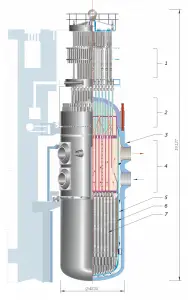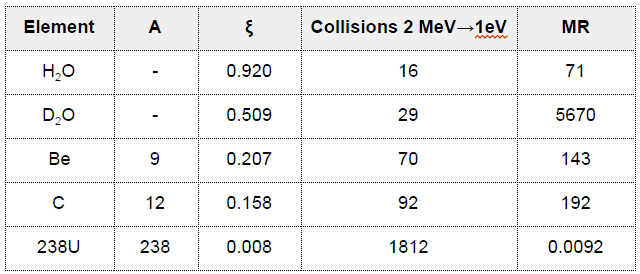The most common nuclear reactors are light water reactors (LWR), in which light water (ordinary water) is used as a moderator and the cooling medium. The use of ordinary water makes it necessary to use an enriched uranium fuel to maintain the reactor’s criticality along the entire fuel cycle (e.g.,, for an 18-month fuel cycle).

1) Control Element Drive Mechanism
2) Reactor vessel head
3) Reactor pressure vessel
4) Coolant inlet-outlet nozzles
5) Downcomer for coolant
6) Neutron reflector
7) fuel assemblies
Source: www.wikipedia.org
Light water reactors are thermal reactors that use thermal neutrons to sustain the chain reaction. In general, LWR’s are divided into two categories:
- Pressurized water reactors (PWR) – are characterized by the high-pressure primary circuit (to keep the water in a liquid state)
- Boiling water reactors (BWR) – are characterized by controlled boiling in the primary circuit.
Pressurized water reactors use a reactor pressure vessel (RPV) to contain the nuclear fuel, moderator, control rods, and coolant. They are cooled and moderated by high-pressure liquid water (e.g.,, at the pressure of 16MPa). At this pressure, water boils at approximately 350°C (662°F). The inlet temperature of the water is about 290°C (554°F). The water (coolant) is heated in the reactor core to approximately 325°C (617°F) as the water flows through the core. As it can be seen, the reactor has approximately 25°C subcooled coolants (distance from the saturation).
Boiling water reactors are cooled and moderated by water like a PWR, but at a lower pressure (of about 7MPa), which allows the water to boil inside the pressure vessel producing the steam that runs turbines. A BWR is like a PWR but with many differences. The BWRs don’t have any steam generators. Unlike a PWR, there is no primary and secondary loop. The thermal efficiency of these reactors can be higher, and they can be simpler and even potentially more stable and safe. But the disadvantage of this concept is that any fuel leak can make the water radioactive and that radioactivity can reach the turbine and the rest of the loop.
Light water as the moderator
To be an effective moderator, the probability of elastic reaction between neutron and the nucleus must be high. In terms of cross-sections, the elastic scattering cross-section of a moderator’s nucleus must be high. Therefore high elastic scattering cross-section is important but does not describe the comprehensive capabilities of moderators. Three new material variables must be defined to describe the capabilities of a material to slow down neutrons:
- The Average Logarithmic Energy Decrement (ξ)
- The Macroscopic Slowing Down Power (MSDP)
- The Moderating Ratio (MR)
Light water has the highest ξ and σs among the moderators (resulting in the highest MSDP) shown in the table. Still, its moderating ratio is low due to its relatively higher absorption cross-section.

Heavy Water Reactors
The most efficient moderator is heavy water. Heavy water has lower ξ and σs but has the highest moderating ratio due to its lowest neutron absorption cross-section. Therefore heavy water is commonly used as a moderator in pressurized heavy water reactors (PHWR). Most PHWR are heavy water-cooled and moderated pressurized water reactors. Instead of using a single large reactor vessel like a PWR or BWR, the nuclear core is contained in hundreds of pressure tubes. PHWRs generally use natural uranium (0.7% U-235) oxide or slightly enriched uranium as fuel. Hence they need a more efficient moderator, in this case, heavy water (D2O).